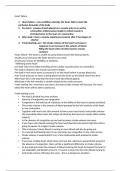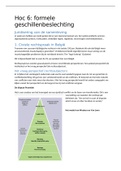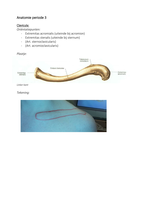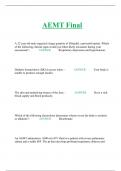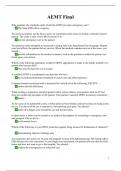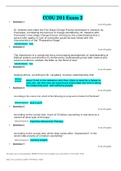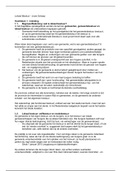Heart failure
1. Heart failure = any condition whereby the heart fails to meet the
perfusion demands of the body
2. Pre-load = passive stretch placed on a muscle prior to an active
contraction; initial passive length to which muscle is
stretched prior to the start of a contraction
3. After-load = force a muscle experiences (exerts) after it has begun to
shorten
4. Frank-Starling Law = the stroke volume of the heart increases in
response to an increase in the volume of blood
filling the heart when all other factors remain
constant.
Heart failure= the heart is unable to pump blood around the body properly.
Usually occurs because the heart becomes too weak.
Or because it loses its flexibility or elasticity.
“Stiffening of the heart”
pre-load- this is the initial stretching of the cardiac myosites prior to contraction.
Pre-load is related to the muscle sarcomere length.
Pre-load is how much stress or pressure is on the heart before it pumps blood out.
How much pressure or stress is being placed on the heart as the blood enters the atria.
After-load- this is the load that the heart must eject blood against.
Afterload of the left ventricle is closely related to the aortic pressure.
Frank-starling law- more force you exert, the more stroke volume will increase, the more
blood the heart will be able to pump out.
Frank starling curve.
• Pre-load is divided into two sections:
• absence of congestion and congestion.
• Congestion is the build up of resistance in the ability of the heart to pump out blood.
• The stroke volume is the amount of blood pumped by the left ventricle of the heart
In one contraction.
• Together with heart rate (the amount of times your heart beats) and stroke volume
this essentially determines the output of blood by the heart per minute (AKA cardiac
output).
• In the absence of congestion as pre load increases stroke volume increases.
• If you have more blood entering the heart and therefore pre load is high then this is
going to equate to a higher stroke volume.
• This is because if more blood is coming in more blood will also be going out.
• In a normal functioning heart it can overcome any congestion it may come across.
• Stroke volume is exponential it is in a fine relationship with preload to stroke
volume.
• If we have a failing heart which does not have the capacity to pump blood around in
the absence of congestion, there will be a significant difference in stroke volume.
• As pre-load increases (the amount of blood entering the heart increases) the heart is
not adaptable and flexible anymore. it cannot account for the extra blood coming in.
• And stroke volume still stays the same.- this is a dangerous situation.
, Heart failure.
• There are different types of heart failure:
• Specific portions of the heart can fail.
• You can have left sided heart failure and right sided heart failure.
• The left side is the more muscular side- it is responsible for pushing blood out
through the systemic circulation where it perfuses your muscles and your tissues.
• Right side is responsible for sending your blood to the lungs where it becomes
oxygenated. And then it comes to the left hand side before it goes out.
• Heart failure can be systemic or it can be pulmonary in nature.
• It can also be congestive. Congestive is anything that causes resistance or
obstacles for the blood to pass out.
• Not only in the circulation but in the heart aswell.
• Signs of heart failure:
• Elevated jugular venous pressure- pressure in the vein is really high.
• Jugular vein receives the blood from the brain.
• If that vein becomes swollen or you can physically examine it to see if it has a
high pressure.
• This is indicative that there is a probleum in the heart for pumping the blood
efficiently.
• In heart failure if there is an inability to profuse the tissues with adequate
amounts of blood and therefore oxygen and nutrients, your heart kicks in with
compensatory mechanisms.
• You’re heart tries to pump faster.
• As a result of that compensation you’re blood pressure increases and the
swelling of the jugular vein is an example of when the heart is trying to
compensate so much, that it is pushing so much blood out, you’re veins start to
swell.
• Another sign of heart failure is the laterally displaced apex beat- apex of the
heart (bottom of the heart shifts over and swivels on its axis and it is tilted
towards the left hand side. The change in positioning produces a slightly different
beat.)
• The rhythm of the heart is slightly displaced.
• In some cases a 3rd heart sound may also be heard.
• If heart failure persists for a long period of time you can almost hear 3 sounds.
• That 3rd sound is almost like a murmur. It is an elongation of the initial sounds.
These are signs that the heart is failing or that there is something wring with it.
• Key symptoms associated with heart failure:
• Cold extremities- youre hand and feet (which are furthest away from you’re
heart) feel really cold. If the heart has a reduced ability to pump blood it is not
going to be profusing those tissues and therefore thermoregulation in these
extremities is reduced.
• Pallor- which is paling of the skin. If the heart is not pumping properly or
purfusing the tissues properly then the skin is going to become pale.
• Fatigue- if you are not getting oxygen to your tissues you are going to feel tired.
1. Heart failure = any condition whereby the heart fails to meet the
perfusion demands of the body
2. Pre-load = passive stretch placed on a muscle prior to an active
contraction; initial passive length to which muscle is
stretched prior to the start of a contraction
3. After-load = force a muscle experiences (exerts) after it has begun to
shorten
4. Frank-Starling Law = the stroke volume of the heart increases in
response to an increase in the volume of blood
filling the heart when all other factors remain
constant.
Heart failure= the heart is unable to pump blood around the body properly.
Usually occurs because the heart becomes too weak.
Or because it loses its flexibility or elasticity.
“Stiffening of the heart”
pre-load- this is the initial stretching of the cardiac myosites prior to contraction.
Pre-load is related to the muscle sarcomere length.
Pre-load is how much stress or pressure is on the heart before it pumps blood out.
How much pressure or stress is being placed on the heart as the blood enters the atria.
After-load- this is the load that the heart must eject blood against.
Afterload of the left ventricle is closely related to the aortic pressure.
Frank-starling law- more force you exert, the more stroke volume will increase, the more
blood the heart will be able to pump out.
Frank starling curve.
• Pre-load is divided into two sections:
• absence of congestion and congestion.
• Congestion is the build up of resistance in the ability of the heart to pump out blood.
• The stroke volume is the amount of blood pumped by the left ventricle of the heart
In one contraction.
• Together with heart rate (the amount of times your heart beats) and stroke volume
this essentially determines the output of blood by the heart per minute (AKA cardiac
output).
• In the absence of congestion as pre load increases stroke volume increases.
• If you have more blood entering the heart and therefore pre load is high then this is
going to equate to a higher stroke volume.
• This is because if more blood is coming in more blood will also be going out.
• In a normal functioning heart it can overcome any congestion it may come across.
• Stroke volume is exponential it is in a fine relationship with preload to stroke
volume.
• If we have a failing heart which does not have the capacity to pump blood around in
the absence of congestion, there will be a significant difference in stroke volume.
• As pre-load increases (the amount of blood entering the heart increases) the heart is
not adaptable and flexible anymore. it cannot account for the extra blood coming in.
• And stroke volume still stays the same.- this is a dangerous situation.
, Heart failure.
• There are different types of heart failure:
• Specific portions of the heart can fail.
• You can have left sided heart failure and right sided heart failure.
• The left side is the more muscular side- it is responsible for pushing blood out
through the systemic circulation where it perfuses your muscles and your tissues.
• Right side is responsible for sending your blood to the lungs where it becomes
oxygenated. And then it comes to the left hand side before it goes out.
• Heart failure can be systemic or it can be pulmonary in nature.
• It can also be congestive. Congestive is anything that causes resistance or
obstacles for the blood to pass out.
• Not only in the circulation but in the heart aswell.
• Signs of heart failure:
• Elevated jugular venous pressure- pressure in the vein is really high.
• Jugular vein receives the blood from the brain.
• If that vein becomes swollen or you can physically examine it to see if it has a
high pressure.
• This is indicative that there is a probleum in the heart for pumping the blood
efficiently.
• In heart failure if there is an inability to profuse the tissues with adequate
amounts of blood and therefore oxygen and nutrients, your heart kicks in with
compensatory mechanisms.
• You’re heart tries to pump faster.
• As a result of that compensation you’re blood pressure increases and the
swelling of the jugular vein is an example of when the heart is trying to
compensate so much, that it is pushing so much blood out, you’re veins start to
swell.
• Another sign of heart failure is the laterally displaced apex beat- apex of the
heart (bottom of the heart shifts over and swivels on its axis and it is tilted
towards the left hand side. The change in positioning produces a slightly different
beat.)
• The rhythm of the heart is slightly displaced.
• In some cases a 3rd heart sound may also be heard.
• If heart failure persists for a long period of time you can almost hear 3 sounds.
• That 3rd sound is almost like a murmur. It is an elongation of the initial sounds.
These are signs that the heart is failing or that there is something wring with it.
• Key symptoms associated with heart failure:
• Cold extremities- youre hand and feet (which are furthest away from you’re
heart) feel really cold. If the heart has a reduced ability to pump blood it is not
going to be profusing those tissues and therefore thermoregulation in these
extremities is reduced.
• Pallor- which is paling of the skin. If the heart is not pumping properly or
purfusing the tissues properly then the skin is going to become pale.
• Fatigue- if you are not getting oxygen to your tissues you are going to feel tired.

